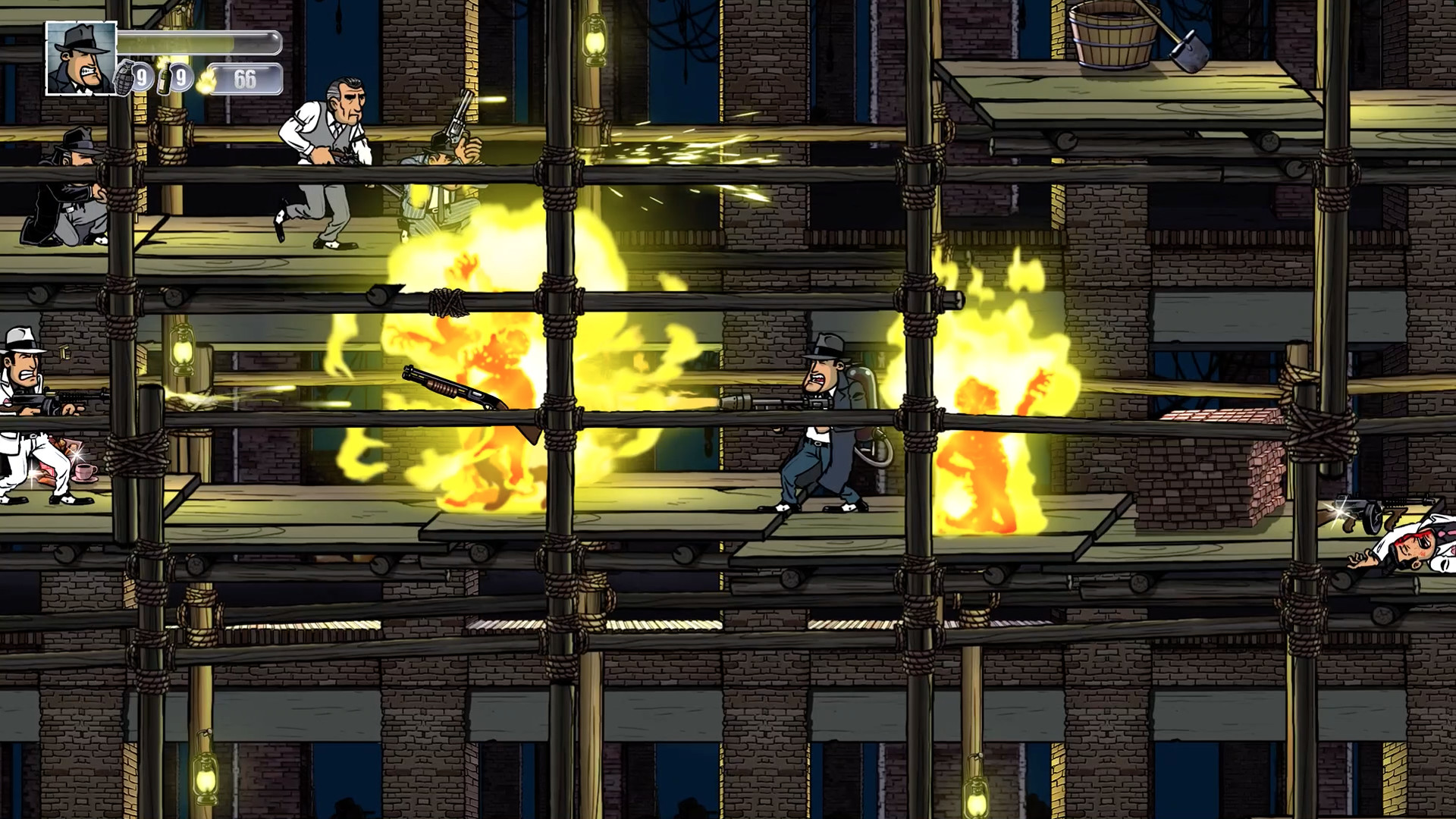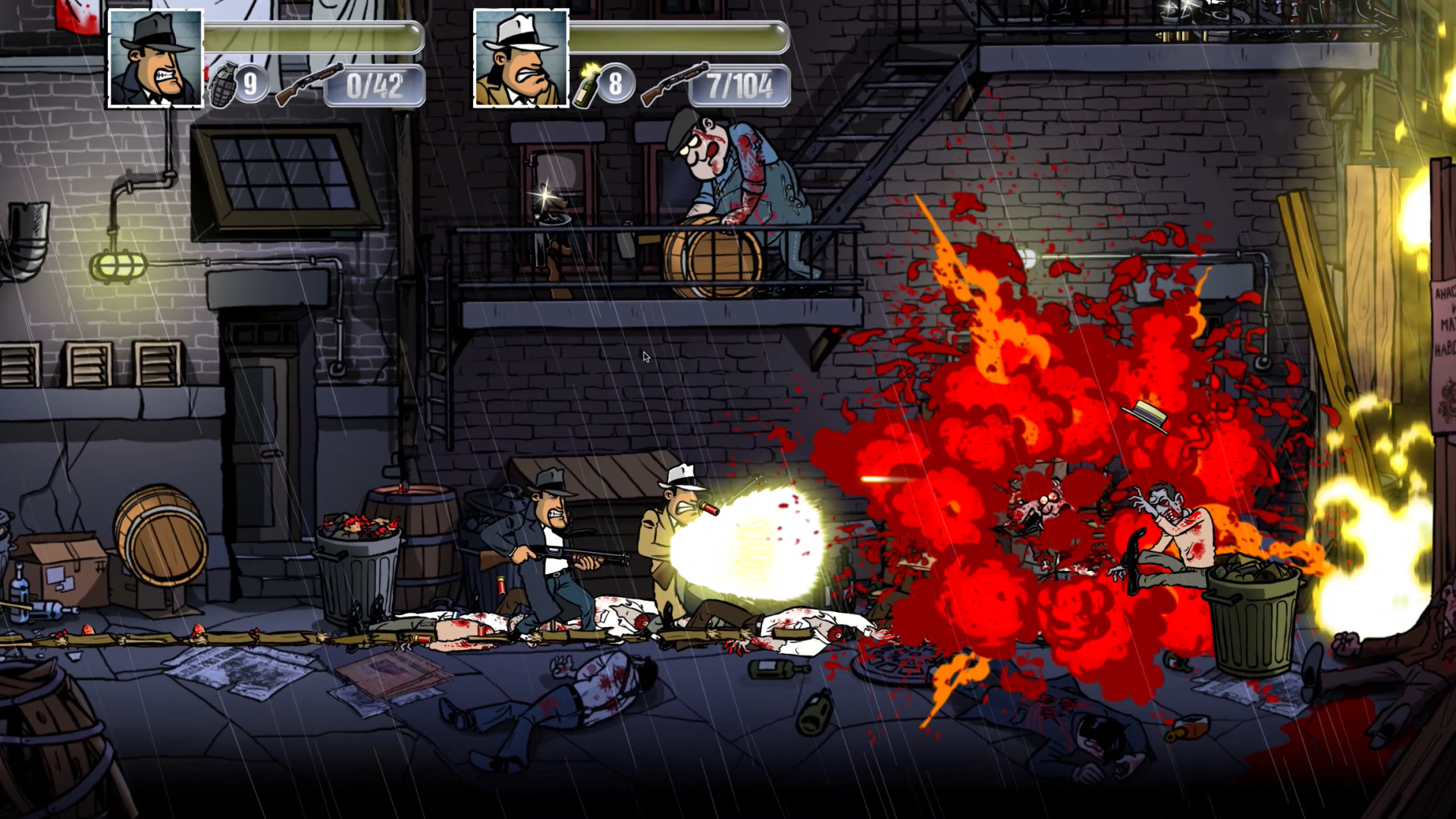 One thing that sets GGC apart from its obvious influence Metal Slug is in the aiming. As in, there isn't any. You don't aim. You just shoot left to right.
One thing that sets GGC apart from its obvious influence Metal Slug is in the aiming. As in, there isn't any. You don't aim. You just shoot left to right.
I'm going to let that one sink in for a second.
Yes, Vinnie and Co don't utilize such advents in human motor skills such as "pointing a gun at a target and shooting it," and instead focus solely on blasting fools in a straight line. This is a shooter without aiming, which makes it completely infuriating when you are attacking baddies slightly above you and unable to hit them. Sure, you can jump and shoot, or duck for crouching targets, but what kind of hitman can't blast someone who is a mere three inches above him? With zombies and mobsters rushing at every angle, I found myself attempting to use the right stick to direct Vinnie's shot, only to have him empty a clip into a harmless wall.
If any of you game designers are reading this right now and are thinking about including a sewer sequence in a video game, you need to stop. No sewer sequence has ever been good in any video game ever, and Guns, Gore, and Cannoli is no exception. The sewer level in this game contains some of the most frustrating enemies of the entire thing, PLENTY of that horrific platforming, and more than a little bit of backtracking after opening up a pathway. All of gamings cardinal sins coalesced in a single environment making that one level, hands down, a miserable experience.

There is a lot to like in Guns, Gore, and Cannoli, from the bizarrely sadistic characters to the really impressive variety in enemy design. The entire game is hampered by unfortunate controls and some bewildering design choices that keep it from really being a great experience. If you want a shooter you can play with friends, this is that, and it does so in a semi-respectable fashion without reinventing a single element. The detractors hit me pretty hard, though, and I'm just not confident this game is an excellent addition to the 2D shooter genre. I'd rather grab a friend and crank through a few levels of any of the Metal Slug games.
Enoch's Thoughts
For me, Guns, Gore, and Cannoli falls apart in two ways: sluggish controls and misguided design choices. Commitment to making a 2D shooter/platformer should imply focus on developing a tight control scheme. When done correctly, the player should feel as though they have full agency over their actions, be they successful or not. The difficulty, then, should stem from a requirement to master said controls, which the player should already subconsciously desire. GGC’s near-instant difficulty ramp about halfway through the game insinuates their wish for such mastery from the player, but Crazy Monkey Studios failed to fine-tune their physics to a point allowing that to happen. Compounding this is their shift in level design. Prior to a certain arc in the story, the game mostly consists of a standard left-to-right-and-occasionally-up environment flow, making the requirement for precision fairly lax and masking the control limitations. Past that point, GGC introduces platforming mechanics that require precise judgement and reflexes from the player, which simply can’t happen. As Taylor said, much of the difficulty in later levels comes not from clever design, but from a frustrating lack of agency.
That said, I’m more than willing to praise Guns, Gore, and Cannoli for the things it does right. Despite a dry, generic premise, the story ventures into some fun, unique areas and introduces a few interesting non-archetypal characters. Paired with the sound design (which falls flat on just a few occasions) and the lovingly crafted visuals, GGC is a welcome entry into the 2D shooter/platformer genre, just not for its mechanics. If you’re willing to absorb more than a couple frustrating deaths into your gaming memory, it’s a good bit of co-op fun that’ll leave you oddly craving some sugary delicacies.
Verdict
Co-Op Score
Overall
The Co-Op Experience: Partner up with 4 local co-op friends and unravel the mystery of the zombie infection.
Co-Optimus game reviews focus on the cooperative experience of a game, our final score graphic represents this experience along with an average score for the game overall. For an explanation of our scores please check our Review Score Explanation Guide.